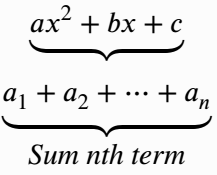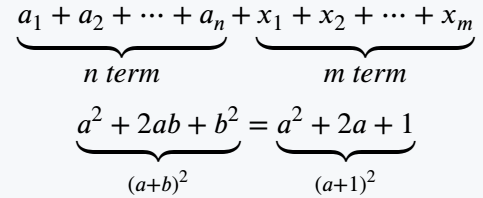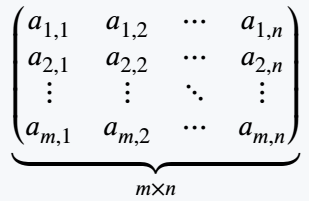Underbrace is a single curly bracket placed below an expression. For example:
LaTeX offers multiple methods to represent this symbol, each with structural differences. This tutorial covers all approaches to help you find answers to your questions.
The \underbrace command in LaTeX works without additional packages, allowing direct use to represent this symbol. For example:
\[ \underbrace{a_1+a_2+a_3+ \cdots + a_n} \]
\[ \underbrace{a_1+a_2+a_3+ \cdots + a_n} \]
Use multiple methods for placing a brace below
Here, multiple packages have been used to demonstrate different methods. Each package contains the same command but differs in structure, as shown in the table below.
| Package | Command |
|---|---|
| MnSymbol | \underbrace{abcd} |
| fdsymbol | \underbrace{abcd} |
| stix | \underbrace{abcd}  |
| mathabx | \underbrace{abcd} |
Multiple lines expression
You may have noticed that different text, number is written under the underbrace. And to represent this syntax, you need to use a subscript with this command.
\documentclass{article}
\usepackage{stix}
\begin{document}
\[ \underbrace{a_1+a_2+\cdots+a_n}_{\textit{n term}}+\underbrace{x_1+x_2+\cdots+x_m}_{\textit{m term}} \]
\[ \underbrace{a^2+2ab+b^2}_{(a+b)^2}=\underbrace{a^2+2a+1}_{(a+1)^2} \]
\end{document}Output :
And the expression is passed as an argument in the subscript to display it below the curved brace symbol.
To place a curly bracket below a matrix
To place a curly bracket below a matrix, the entire environment must be enclosed within the corresponding command as an argument.
\documentclass{article}
\usepackage{stix,amsmath}
\begin{document}
\[\underbrace{
\begin{pmatrix}
a_{1,1} & a_{1,2} & \cdots & a_{1,n} \\
a_{2,1} & a_{2,2} & \cdots & a_{2,n} \\
\vdots & \vdots & \ddots & \vdots \\
a_{m,1} & a_{m,2} & \cdots & a_{m,n}
\end{pmatrix}}_{m \times n}\]
\end{document}Output :



Perfect solution for Underbrace. I tried another way but didn’t work.
Congratulations!